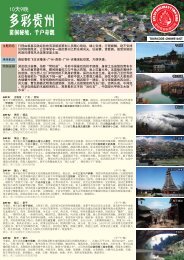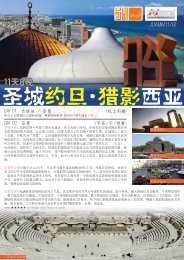Untitled
Untitled
Untitled
- No tags were found...
Create successful ePaper yourself
Turn your PDF publications into a flip-book with our unique Google optimized e-Paper software.
DAY 01 Kuala Lumpur / IstanbulAssemble at KLIA international terminal for overnight flight to Istanbul.(MOB)DAY 02 Istanbul(MOB/L/D)Hagia Sophia is a former Orthodox patriarchal basilica, later a mosque, and now a museum in Istanbul, Turkey. From the date of its dedication in 360 until 1453, it served as anEastern Orthodox cathedral and seat of the Patriarchate of Constantinople, except between 1204 and 1261, when it was converted to a Roman Catholic cathedral under the LatinEmpire. The building was a mosque from 29 May 1453 until 1931, when it was secularized. It was opened as a museum on 1 February 1935.Topkapi Palace is a large palace in Istanbul, Turkey, that was the primary residence of the Ottoman Sultans for approximately 400 years (1465-1856) of their 624-year reign. Aswell as a royal residence, the palace was a setting for state occasions and royal entertainments. It is now a major tourist attraction and contains important holy relics of the Muslimworld, including Muhammed's cloak and sword. The Topkapi Palace is among the monuments contained within the "Historic Areas of Istanbul", which became a UNESCO WorldHeritage Site in 1985, and is described in Criterion iv as "the best example of ensembles of palaces of the Ottoman period."The Basilica Cistern (Turkish: Yerebatan Sarayı or Yerebatan Sarnıcı), is the largest of several hundred ancient cisterns that lie beneath the city of Istanbul (formerly Constantinople),Turkey. The cistern, located 500 feet southwest of the Hagia Sophia on the historical peninsula of Sarayburnu, was built in the 6th century during the reign of ByzantineEmperor Justinian I. Historical texts claim that 7,000 slaves were involved in the construction of the cistern. The enlarged cistern provided a water filtration system for the GreatPalace of Constantinople and other buildings on the First Hill, and continued to provide water to the Topkapi Palace after the Ottoman conquest in 1453 and into modern times.The Sultan Ahmed Mosque (Turkish: Sultanahmet Camii) is an historical mosque in Istanbul. The mosque is popularly known as the Blue Mosque for the blue tiles adorningthe walls of its interior. It was built from 1609 to 1616, during the rule of Ahmed I. Like many other mosques, it also comprises a tomb of the founder, a madrasah and a hospice.While still used as a mosque, the Sultan Ahmed Mosque has also become a popular tourist attraction.Hotel: 5 stars Crowne Plaza Old City or Sheraton Maslak or similarTopkapi Palace The Basilica Cistern Hagia SophiaDAY 03 Istanbul / PamukkaleThe Blue Mosque(B/L/D)Special arrangement a domestic flight from Istanbul to Pamukkale (Denizli Cardak Airport), shorten traveling time.Pamukkale, meaning "cotton castle" in Turkish, is a natural site in Denizli Province in southwestern Turkey. The city contains hot springs and travertines, terraces of carbonateminerals left by the flowing water. It is located in Turkey's Inner Aegean region, in the River Menderes valley, which has a temperate climate for most of the year. People have bathedin its pools for thousands of years. As recently as the mid-20th century, hotels were built over the ruins of Hieropolis, causing considerable damage. An approach road was built fromthe valley over the terraces, and motor bikes were allowed to go up and down the slopes. When the area was declared a World Heritage Site, the hotels were demolished and the roadremoved and replaced with artificial pools. Wearing shoes in the water is prohibited to protect the deposits.Hierapolis was an ancient Greco-Roman city in Phrygia located on hot springs in southwest Anatolia. Its ruins are adjacent to modern Pamukkale, Turkey. Hierapolis is a UNESCOWorld Heritage Site. The hot springs there have been used as a spa since the 2nd century BCE, and people came to soothe their ailments, with many of them retiring or dying here.The large necropolis is filled with sarcophagi, including the Sarcophagus of Marcus Aurelius Ammianos. The great baths were constructed with huge stone blocks without the useof cement, and consisted of various closed or open sections linked together. There are deep niches in the inner section of the bath, library, gymnasium and other closed or openlocations. The complex, which was constructed in the 2nd century BCE, constitutes a good example of vault type architecture. The complex is now an archaeological museum.Hotel:SPA Hotel Colossae Thermal or Pam Thermal Hotel or similarPamukkaleHierapolisHierapolisPamukkale




